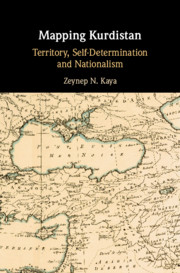Book contents
- Mapping Kurdistan
- Mapping Kurdistan
- Copyright page
- Dedication
- Contents
- Maps
- Acknowledgements
- Note on Text
- Abbreviations
- Introduction
- 1 Kurdish Territoriality under Ottoman Rule
- 2 Orientalist Views of National Identity and Colonial Maps of Kurdistan
- 3 Wilsonian Self-Determination
- 4 Kurdish Nationalism during Decolonisation and the Cold War
- 5 Kurds and the International Society after the Cold War
- 6 Kurdish Diaspora
- Conclusion
- Bibliography
- Index
Introduction
Published online by Cambridge University Press: 12 June 2020
- Mapping Kurdistan
- Mapping Kurdistan
- Copyright page
- Dedication
- Contents
- Maps
- Acknowledgements
- Note on Text
- Abbreviations
- Introduction
- 1 Kurdish Territoriality under Ottoman Rule
- 2 Orientalist Views of National Identity and Colonial Maps of Kurdistan
- 3 Wilsonian Self-Determination
- 4 Kurdish Nationalism during Decolonisation and the Cold War
- 5 Kurds and the International Society after the Cold War
- 6 Kurdish Diaspora
- Conclusion
- Bibliography
- Index
Summary
The introductory chapter sets the conceptual and theoretical scene for the book. It justifies why examining the formative role of self-determination and territoriality is important to understand why and by whom the map of Kurdistan is produced and used, and how it is perceived. It argues that, as a means of communicating Kurdish nationalist ideals to international society, the map of Kurdistan is generated and perceived through prevalent assumptions on the link between nation and territory. These assumptions derive from the principle of self-determination. Changes in the meaning and function of self-determination have also changed assumptions on the link between nation and territory. Therefore, self-determination and the way in which the nation-territory link was understood had a formative role in the use and perception of the map of Kurdistan.
- Type
- Chapter
- Information
- Mapping KurdistanTerritory, Self-Determination and Nationalism, pp. 1 - 20Publisher: Cambridge University PressPrint publication year: 2020

